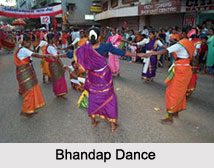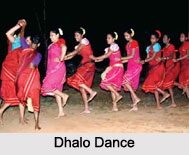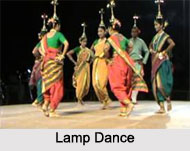 Folk Dances of Goa put up with a tradition of thousands of years, characterized by countless forms performed by and reflecting lifestyles, cultures and aspirations of diverse strata, religions and castes of Goan society. Goa has an exclusive cultural heritage, rich and lively and it is recognized for quite a few folk festivals and performances.
Folk Dances of Goa put up with a tradition of thousands of years, characterized by countless forms performed by and reflecting lifestyles, cultures and aspirations of diverse strata, religions and castes of Goan society. Goa has an exclusive cultural heritage, rich and lively and it is recognized for quite a few folk festivals and performances.
Folk Dances of North Goa are as follows:
Bhandap: This is a traditional folk dance performed by the women folk of the scheduled tribe community who were the earliest settlers of Goa. That includes the second half of the Hindu month Bhadrapada.
Corredinho: This is a type of Portuguese folk dance. It is a type of dance, which is popular among Goan elite youth.
 Dhangar Dance: This dance is mainly performed in Navaratri days. This is a vigorous session of worship dance.
Dhangar Dance: This dance is mainly performed in Navaratri days. This is a vigorous session of worship dance.
Dekhni-Beauty dance: Only women perform this dance form. This form displays a rare blend of Indian and Western rhythms.
Dhalo: Dhalo is performed by women folk on the moonlit night of `Pausha` month. Compared to Fugdi dance, this dance is deliberate. The songs are in Konkani and Marathi. Normally 12- 24 women assemble after the dinner at a pre-selected specific spot in the square of a house in the village.
Ghode Modni: This dance form is performed in commemoration of the "return of the Ranes" after victories over the Portuguese in Bicholim and Satari Taluka.
Dhangar Dance: During Navaratri celebration, the leader of the house observes self-denial and fast, takes bath at early hours in the morning, single one cup of milk per day and prays and dances before the family deity.
Romat Dance: This thanks-giving traditional dance-cum-parade performed in the Shigmo festival is known as Romat in the northern Goa and Mell in the central Goa. It is particularly crowded, loud and colourful matter.
Lamp Dance: Women holding lamps on their heads perform this during Shigmo Festival. Thus this is only restricted to womenfolk.
Mussal Dance: The Kshatriyas, the soldier class of `Chandor` carry out this dance-cum-song to rejoice the triumph of Harihar, the Hindu King of Vijaynagar over the Cholas in the early 14th century.
Kunbi Dance: This is the tribal Folk dance. A group performs this where dance and songs are performed thoroughly.
Tonyamel: This a type of folk dance that is performed with sticks. This is a very vigorous and muscular group dance, which is connected with the farm-folk celebrating the joys of good harvest. Tipri Nritya resembles tonyamel folk dance, which is very popular throughout the whole Goa.
Veerbhadra: It is a typical Indian style dance performed in Ponda, Sanguem and Bicholim Talukas.
Goff: In the village of Poiguinim, a group of men move from house to house performing this dance. Multi-coloured ropes are suspended from the roof of the matov (canopy). Each dancer holds one rope and to the beat of the song, performs the dance twining the ropes in the method to form a cord. Then they perform turn round movements to untwine the ropes.
Morulem: This is a traditional folk dance presented by the backward community during Shigmo Festival.
Zagor: This is mainly a folk Play. This is a cultural activity presented in different villages of Goa in different styles by the Gauda community.




